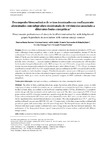Please use this identifier to cite or link to this item:
http://www.alice.cnptia.embrapa.br/alice/handle/doc/532595| Title: | Desempenho bioeconômico de ovinos terminados em confinamento alimentados com subproduto desidratado de vitivinícolas associado a diferentes fontes energéticas. |
| Authors: | BARROSO, D. D.  ARAÚJO, G. G. L. de   HOLANDA JÚNIOR, E. V. de   GONZAGA NETO, S.   MEDINA, F. T.   |
| Affiliation: | DAERSON DANTAS BARROSO, UNIVERSIDADE FEDERAL DA PARAÍBA GHERMAN GARCIA LEAL DE ARAÚJO, CPATSA EVANDRO VASCONCELOS DE HOLANDA JÚNIOR, CNPC SEVERINO GONZAGA NETO, UNIVERSIDADE FEDERAL DA PARAÍBA FERNANDO THOMAZ MEDINA, UNIVERSIDADE FEDERAL DO CEARA. |
| Date Issued: | 2007 |
| Citation: | Revista Ciência Agronômica, v. 38, n. 2, p. 192-198, 2007. |
| Description: | Resumo: Avaliou-se o efeito de dietas para ovinos contendo subproduto desidratado de vitivinícolas (SDV) associado a diferentes fontes energéticas, sobre o ganho de peso e a relação custo/benefício, durante 63 dias de confinamento. Foram utilizados dezoito ovinos machos SRD, não castrados, com aproximadamente sete meses de idade e 23 kg de peso vivo inicial, seguindo-se o delineamento em blocos casualizados com três tratamentos e seis repetições. As dietas foram compostas de 50% de resíduo de vitivinícolas e 50% de concentrados energéticos: grão de milho moído (Zea mays L.), raspa de mandioca (Manihot esculenta Crantz.) enriquecida com 1,8% de uréia e farelo de palma forrageira (Opuntia ficus indica Mill.) enriquecido com 1,1% de uréia, em que todos os ingredientes tiveram seu custo de produção estimados. Os ganhos de peso médio diários foram 117; 71 e 132 g e, as relações custo/benefício foram 0,68; 0,61 e 1,01, respectivamente, para as combinações de SDV com grão de milho moído, raspa de mandioca e farelo de palma forrageira. O melhor desempenho e menor custo obtido para a associação do subproduto de vitivinícolas ao farelo de palma forrageira proporcionaram os melhores indicadores financeiros. O desempenho obtido pelos ovinos revelou um bom potencial forrageiro do SDV combinado a diferentes fontes energéticas. Bloeconomic performance of sheep in feedlot termination fed with dehydrated grapes byproducts in association with various energy sources. Abstract: The effect of diets combining dehydrated grapes byproducts with different energy sources on daily weight gain of sheep in feedlot termination and on cost/benefit was evaluated during 63 days. Eighteen seven months-old male sheep, non-gelded, no defined breed, weighting initially 23.0 kg, distributed on a completely random design with three treatments and six replications were used. The diets were composed of 50% of dried grapes residue and 50% of energy concentrates: ground corn grain (Zea mays L.), cassava (Manihot esculenta Crantz.) chips enriched with 1.8% of urea, and cactus (Opuntia ficus indica Mill.) meal enriched with 1, 1% of urea. All the ingredients in the diets had their production cost estimated. The daily weight gains were 117, 7 1, and 132 g, and the cost/benefit analyses were R$ 0.68, 0.6 1, and 1.01, respectively, for the dried grapes residue combined with ground corn grain, with cassava chips and with cactus forage meal. The best performance and the cheaper diet, obtained with dried grapes residue combined with cactus forage meal, gave the best financial indicators. The performance of the sheep period showed a good forage potential for winery residues combined with different energy sources. |
| Thesagro: | Ovino Nutrição Animal Alimento Para Animal Mandioca Manihot esculenta Opuntia ficus indica Zea mays Milho Análise Econômica Confinamento Dieta Ganho de Peso Subproduto |
| NAL Thesaurus: | Sheep feeding Animal performance Ruminant nutrition Digestibility Feedlots Cassava Brazil |
| Keywords: | Desempenho animal Residuo agroindustrial Brasil Semi-árido Nordeste Economic evaluation Feedlot of sheep Grain Maize Ruminal fermentation Economic aspects |
| Type of Material: | Artigo de periódico |
| Access: | openAccess |
| Appears in Collections: | Artigo em periódico indexado (CNPC)  |
Files in This Item:
| File | Description | Size | Format | |
|---|---|---|---|---|
| APIDesempenhobioeconomicodeovinosterminadosemconfinamento.pdf | 64.66 kB | Adobe PDF |  View/Open |









